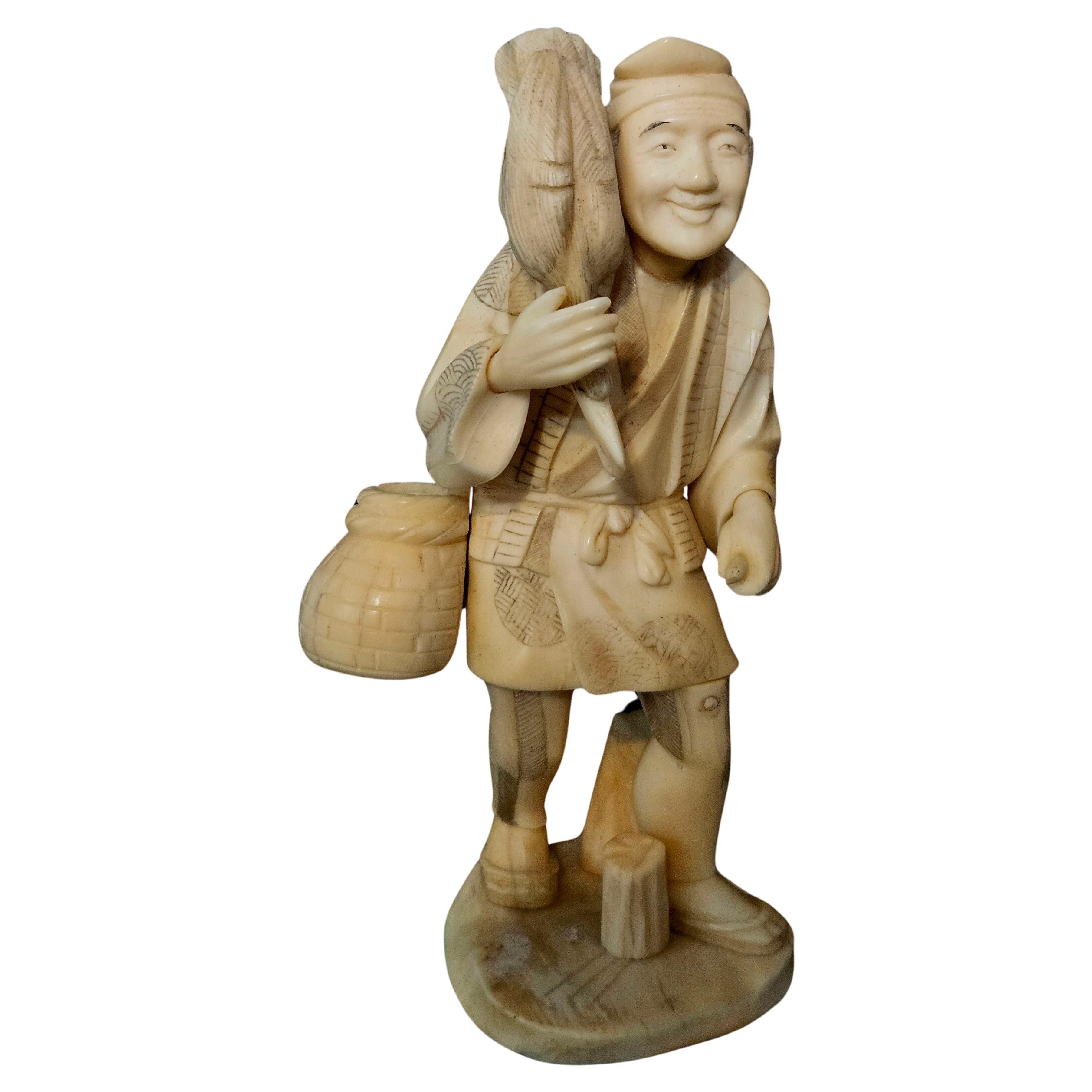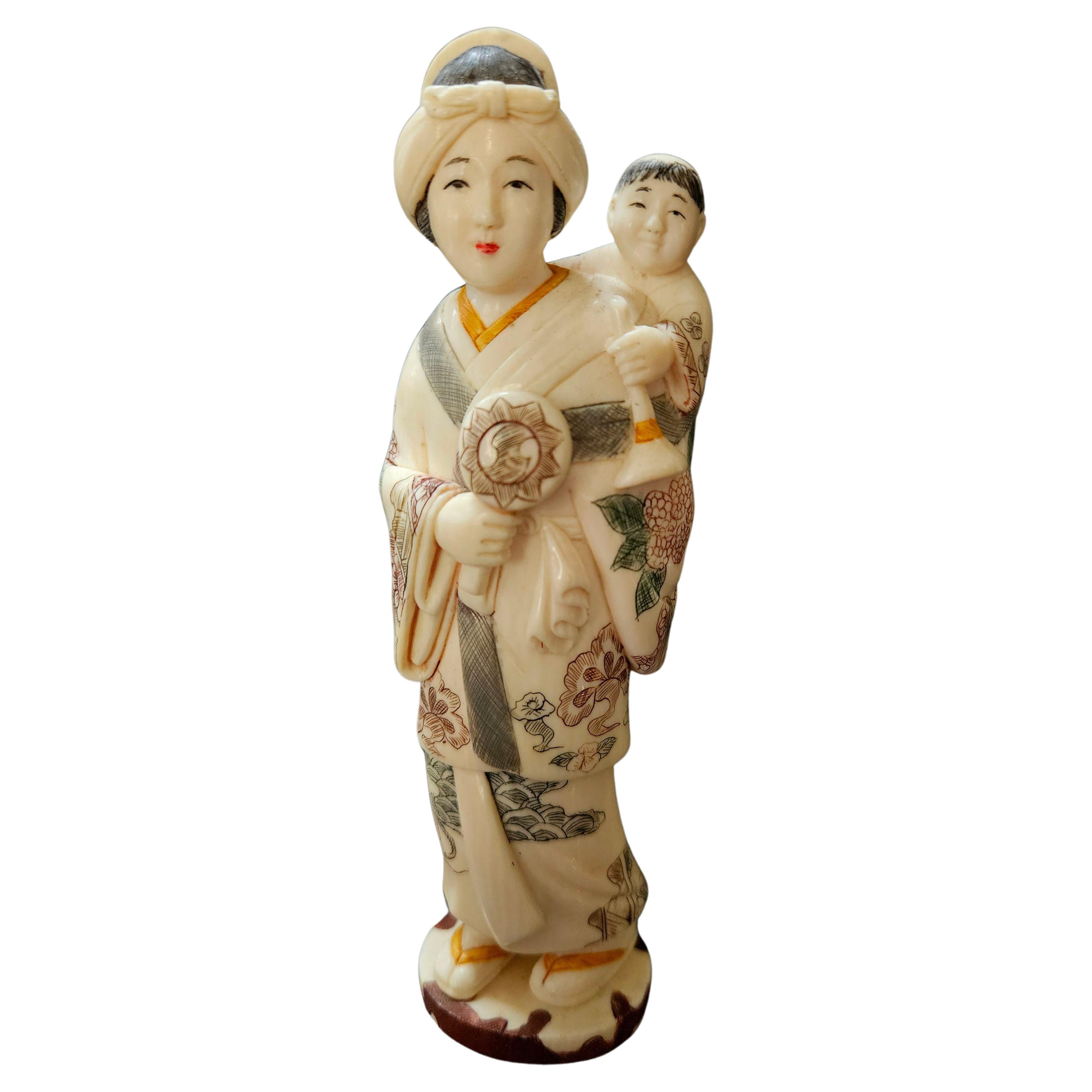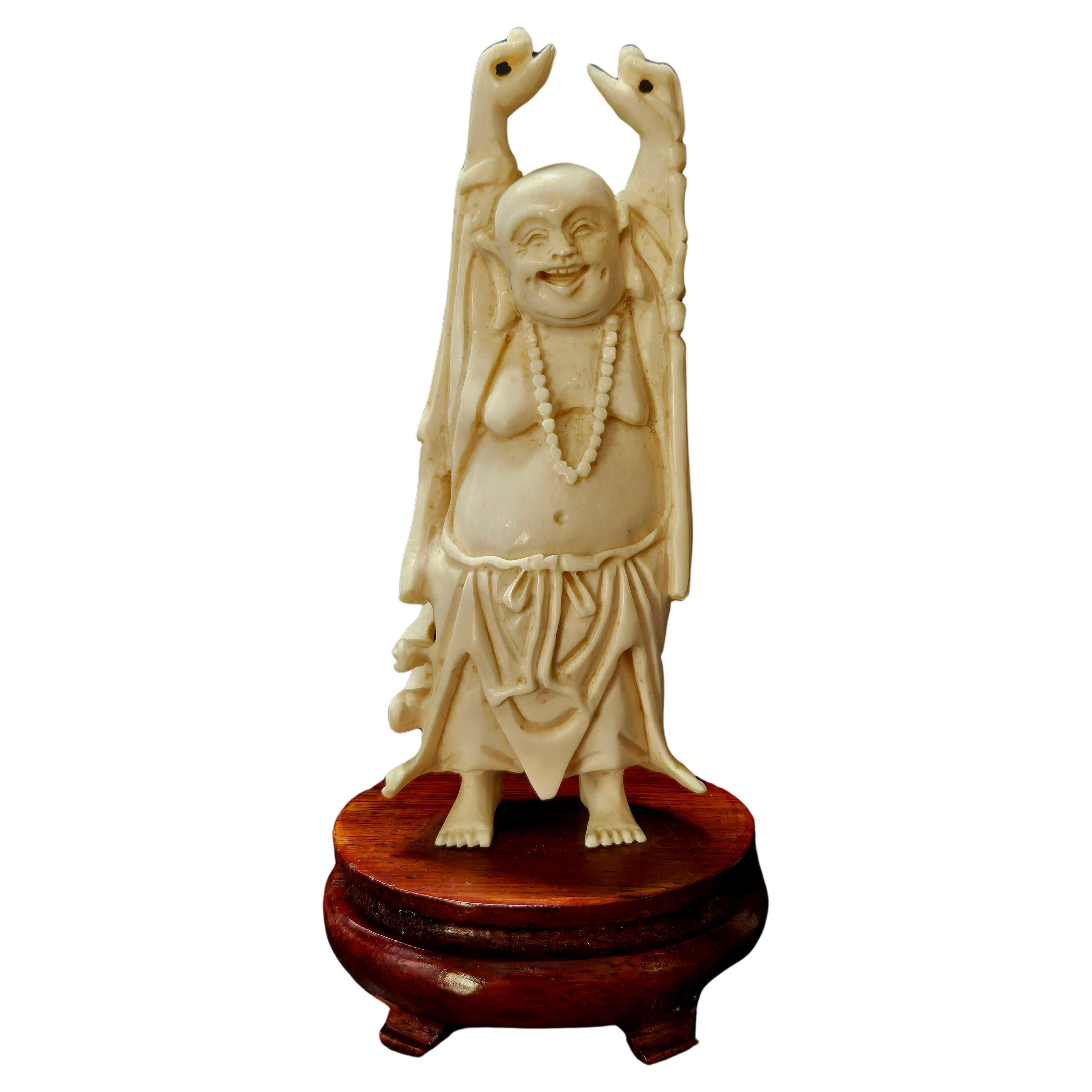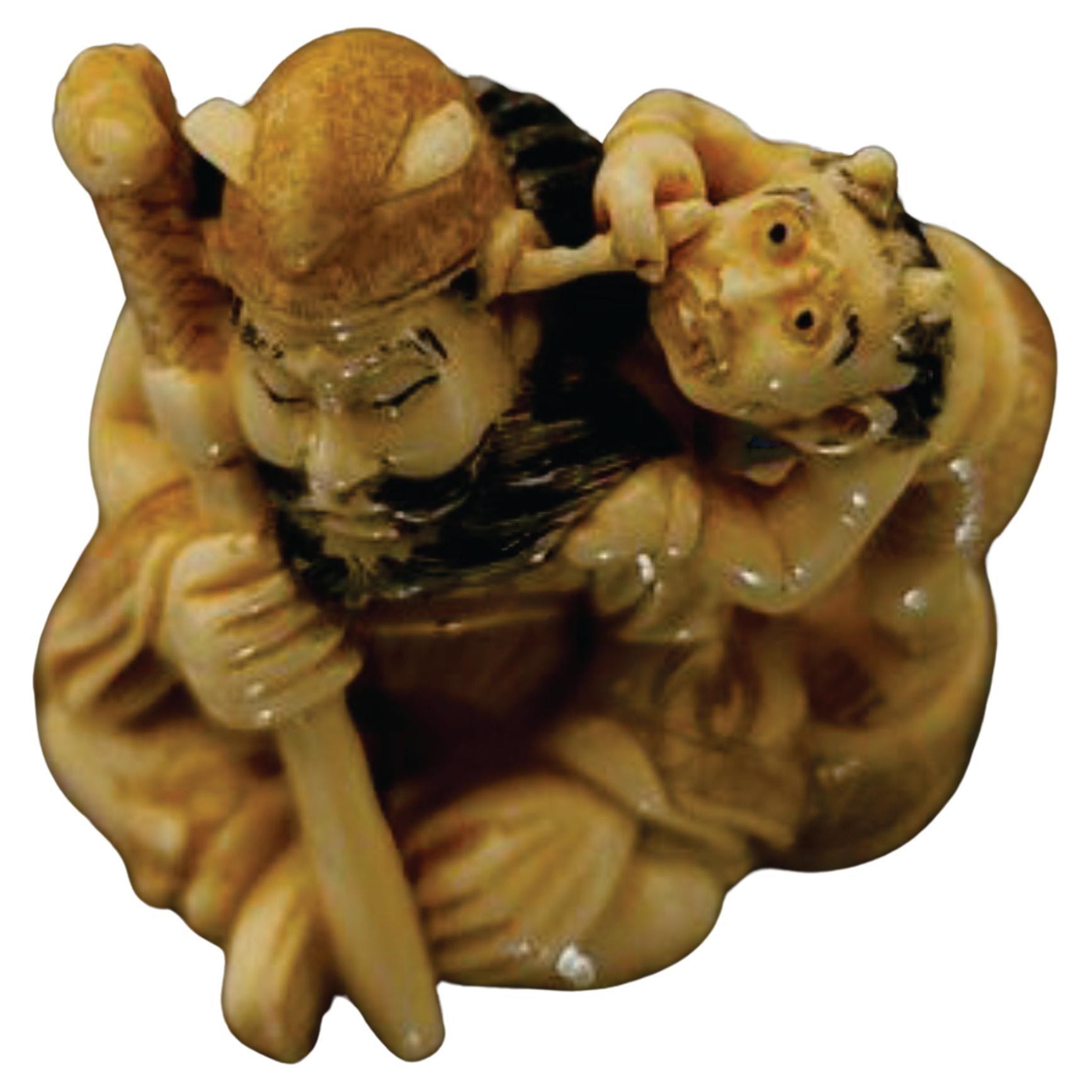Items Similar to Japan Carved Okimono Group Of A Fisherman and His Kid, 1890 Meiji, Signed
Video Loading
Want more images or videos?
Request additional images or videos from the seller
1 of 18
Japan Carved Okimono Group Of A Fisherman and His Kid, 1890 Meiji, Signed
About the Item
Japan, Meiji Period, a finely carved figurine with outstanding detail of a fisherman and his kid. The man has a peddle on his right and a fisher on his left hand. The kid also has a fisher on his back and it can be seen from the backside.
The artist signed his name on the bottom
This caving style was trendy in Japan in the Meiji Period around the 1880s.
Condition: Excellent with wear consistent with age and use. The overall condition of this piece is excellent. Besides the little normal wear, there is no damage to any parts. All pieces are secured in their settings. This piece has been carefully inspected to guarantee its condition and authenticity.
- Dimensions:Height: 5.75 in (14.61 cm)Width: 3.5 in (8.89 cm)Depth: 2.5 in (6.35 cm)
- Materials and Techniques:
- Place of Origin:
- Period:
- Date of Manufacture:19th Century
- Condition:Wear consistent with age and use. Wear consistent with age and use.
- Seller Location:Norton, MA
- Reference Number:1stDibs: LU5848239438452
About the Seller
5.0
Platinum Seller
These expertly vetted sellers are 1stDibs' most experienced sellers and are rated highest by our customers.
Established in 2000
1stDibs seller since 2021
85 sales on 1stDibs
Typical response time: <1 hour
- ShippingRetrieving quote...Ships From: Norton, MA
- Return PolicyA return for this item may be initiated within 3 days of delivery.
More From This SellerView All
- Japan Carved Okimono Group Of A Goose and Its Seller, 1890 MeijiLocated in Norton, MAJapan, Meiji Period, a finely carved figurine with outstanding detail of a Goose and its Seller. The man is carrying a goose on his right shoulder with a basket on the waist on the w...Category
Antique 1880s Japanese Decorative Boxes
MaterialsIvory, Paint
- Japan Carved Okimono Group Of Floral and stained Sculpture, 1890 MeijiLocated in Norton, MAJapan, Meiji Period, a finely carved floral and stained sculpture sits on a vase with outstanding detail in s supper elegant aperience. This caving style was trendy in Japan in the M...Category
Antique 1880s Japanese Decorative Boxes
MaterialsIvory, Paint
- Antique Japanese Carved Okimono Mixed Material Figure Group Mother & Son, MeijiLocated in Norton, MAAntique Japanese Carved Okimono Mixed Material and Polychrome Figure Group Mother & Son, Meiji Period This item is 2" wide x1 5/8" deep x 6" high in dimension, from the late 19th c...Category
Antique 19th Century Japanese Decorative Boxes
MaterialsIvory, Paint
- Antique Japanese Carved Okimono Happy Buddha, Meiji PeriodLocated in Norton, MAAntique Japanese Carved Okimono Mixed Material Figure "Happy Buddha on Stand", Meiji Period This item is 2" wide x1.5" deep x 5" high in dimension, the wood stand measures 3" W x 2...Category
Antique 19th Century Japanese Decorative Boxes
MaterialsIvory, Paint
- Japanese Carved Netsuke Mixed Material Figure Group, Signed by Tomoaki, MeijiLocated in Norton, MAJapanese Carved Netsuke Mixed Material Figure Group, Signed by Tomoaki, Meiji period. Ric.NA005 A truly hand-carved ivory figure group, depicting a ghostbuster holding a sword, and ...Category
Antique 19th Century Japanese Decorative Boxes
MaterialsIvory, Paint
- Japanese Carved Netsuke Mixed Material Figure, Signed by Matsuyoshi, MeijiLocated in Norton, MANetsuke Japanese Hand-Carved Mixed Material Figure, Signed by Matsuyoshi, from the Meiji period. Ric.NA003 A truly hand-carved mixed material figure, A Wise Man Holding a Rope, shows...Category
Antique 19th Century Japanese Decorative Boxes
MaterialsIvory, Paint
You May Also Like
- Japan 1890 Meiji Period Signed Okimono Sculpture of a Group of Skeletons SmokingLocated in Miami, FLSculptural signed Okimono from the Japanese Meiji period (1868-1912). Very rare, unusual and large sculptural assembling of a dysplaying piece of okimono. Created in Japan during the imperial period of the Meiji (1868-1912). This extraordinary okimono was carefully carved depicting a group of three intricately and realistically rendered carousing skeletons (Gaikotsu) in relax and resting position, drinking and smoking. Two of them, probably males representations are resting on a wicker sofa. The third, is a woman seated in a lower stool offering drinking cups of sake on a round tray. A small rectangular bench is arranged in the scene. The composition is displayed on a four-legged carved wood platform with an inlaid red plaque engraved with the artist's signature. The level of detail and the quality of the carving is truly exceptional. Has an exact measurements of 209.55 mm by 196.85 mm by 127.76 mm (8.25 x 7.75 x 5.03 Inches). After an extensive collection of data, comparables and references to this piece, we have only been able to find only three okimono sculptures like this with similar themes and the same quality of work. References Note: A similar carving of four skeletons playing an animated game of dominos, signed Shutaro in an inlaid rectangular red plaque, was sold in London by Christie’s South Kensington in October 14 2014, Lot 120 Sale 5546. References Note: A similar carving with four skeletons in an otherwise typical victorian scene of a photographer and three sitters signed Shutaro in an inlaid rectangular red plaque, was sold in Edinburgh at Lyon & Turnbull in November 7, 2018. References Note: A similar carving with five skeletons seated, playing cards and drinking, was sold in London by John Nicholson Fine Art on September 26, 2018. Meiji period, is an era of Japanese history that extended from October 23, 1868 to July 30, 1912. The Meiji era was the first half of the Empire of Japan, when the Japanese people moved from being an isolated feudal society at risk of colonization by Western powers to the new paradigm of a modern, industrialized nation state and emergent great power, influenced by Western scientific, technological, philosophical, political, legal, and aesthetic ideas. As a result of such wholesale adoption of radically different ideas, the changes to Japan were profound, and affected its social structure, internal politics, economy, military, and foreign relations. The period corresponded to the reign of Emperor Meiji. It was preceded by the Keio era and was succeeded by the Taisho era, upon the accession of Emperor Taisho. Okimono, is a Japanese term meaning for display an ornament; art object; or decorative object, usually displayed in a tokonoma or butsudan "Buddhist altar". It is an ornament or figure, especially one placed in a guest room. An okimono may be a small Japanese...Category
Antique 1890s Japanese Meiji Sculptures and Carvings
MaterialsWood
- Japanese Meiji Period Silver Box Signed MasayukiLocated in Newark, EnglandJapanese Meiji period silver box with shibuichi plaque dating circa 1900. The box of rectangular form with a silver polished case stamped Jungin (J...Category
Antique Early 1900s Meiji Metalwork
MaterialsSilver
- Japanese Meiji Period Carved Large Turtle OkimonoLocated in New York, NYA Japanese Meiji Period late 19th, early 20th century carved boxwood turtle okimonoCategory
20th Century Japanese Sculptures
MaterialsBoxwood
- Signed Japanese White Lacquer and Maki-E Lacquer Tansu, Meiji PeriodLocated in Ottawa, OntarioThe case decorated overall in crackle-glaze white lacquer and fitted with a patinated metal carrying handle over three tiers of small drawers. The first two tiers are comprised of a ...Category
Antique Late 19th Century Japanese Meiji Lacquer
MaterialsLacquer
- Japanese Bronze and Mixed Metal Box, Signed To Base, Meiji PeriodLocated in Melbourne, VictoriaA rare Japanese Meiji period (1868 - 1912) circular bronze box and cover by Inoue, Kyoto, late 19th century. The cover embossed with gilt, silvered and coppered decoration of inse...Category
Antique Late 19th Century Japanese Metalwork
MaterialsBronze
- Japanese Marquetry and Lacquer Jewelry Chest, Meiji Period, circa 1900, JapanLocated in Austin, TXA very attractive Japanese wood table top jewelry or collector's chest with marquetry and lacquer decoration, Meiji period, circa 1900, Japan. Previously in the collection of Asbjorn Lunde (1927 - 2017). The chest is crafted in the form of a Chinese seal...Category
Antique Early 1900s Japanese Meiji Lacquer
MaterialsWood, Softwood, Lacquer





